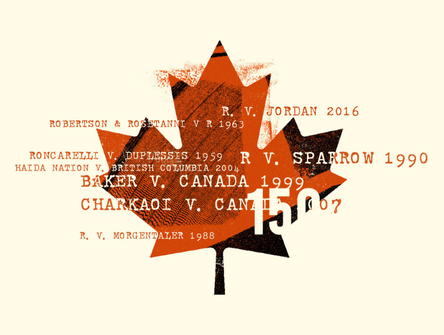Fifteen years after Gladue, what progress?
The Supreme Court of Canada judgment has not had its intended effect.

Nearly fifteen years have passed since the Gladue case was decided by the Supreme Court of Canada in 1999: it must be understood by all persons appearing (or presiding) in a Canadian court when an aboriginal offender is to be sentenced for some crime whether it be minor or very serious. The decision was truly groundbreaking – it demanded real and fundamental changes from the courts. The decision was intended to address the over-incarceration of aboriginal persons in Canada’s prisons.
Jamie Gladue, a young aboriginal woman, had entered a guilty plea to manslaughter and was sentenced to three years in prison by a judge of the Supreme Court of B.C. She had stabbed and killed her boyfriend in a drunken argument over his having cheated on her during their relationship. The SCC did not reduce her sentence but the unanimous decision made it clear that the approach to sentencing by the court, while not unusual, had been seriously inadequate – and that must change.
That the judgment from the highest court in the country has not had the intended effect became evident when the court revisited the issue in two cases in 2012.
Manasie Ipeelee, an Inuk man, had been sentenced in Ontario. Frank Ladue, a member of the Kaska Nation from Ross River, Yukon, had been sentenced in B.C. Both were long-term offenders and sentenced for failing to comply with their long term supervision orders. The SCC repeated – in even stronger terms – the principles stated in the Gladue decision. (Frank Ladue had been sentenced to three years in prison by a B.C. provincial court judge who had given little if any consideration to his “tragic life circumstances.” The BCCA had reduced his sentence to one year).
The essential elements of Gladue by the SCC may be summarized as follows:
- The Canadian criminal justice system has failed the Aboriginal Peoples of Canada (Gladue paras. 60-62, 70; see also Ipeelee para. 62.);
- It is unhappily true that across Canada, aboriginal people commit a disproportionate number of crimes. This fact is intimately tied to the legacy of Colonialism. (Gladue paras. 65 & 67; Ipeelee paras. 60, 65 & 77);
- Canadian judges, when sentencing for criminal offences, have focused on Anglo-Saxo traditions and the statutory provisions of the criminal code (Gladue para’s 42 & 43; Ipeelee para. 35);
- Aboriginal Peoples have different concepts of justice.(Gladue paras. 37 & 70);
- The Aboriginal Peoples of Canada are not the same as everybody else. (Gladue para. 37; Ipeelee para. 77);
- Amendments to the criminal code in 1996 were intended to bring about real change. Judges were told they must do their work differently. (Gladue para’s 33 & 64; Ipeelee paras. 59, 68 & 69);
- The proper approach to the sentencing of aboriginal offenders requires that:
- The judge must pay real and particular attention to the background factors of the person before the court (Gladue paras. 66 & 69);
- The judge must take judicial notice of the systemic factors which haveinfluenced the lives of all aboriginal persons in Canada (Gladue para. 83);
- The judge must also acquire real information about he life circumstances of the person before the court (Gladue paras. 83 & 84, and #7).
- There are four specific principles that must be kept in mind:
- The Gladue approach applies to the sentencing of all aboriginal offenders: it is not restricted to persons who live “on reserve.” (Gladue #11, at p. 55);
- The Gladue approach does not mean that an aboriginal offender should receive a “race-based discount.” (Gladue #9, p. 54; Ipeelee paras. 71 & 75);
- Prison is always the penal sanction of last resort (Gladue para. 36);
- An aboriginal offender appearing before the court to be sentenced may choose to waive the gathering of Gladue information that is specific to his or her personal circumstances (Gladue para. 83, and #7, p. 54). (There is good reason to be concerned that this qualification not be misunderstood or abused: the SCC did not intend that sentencing judges routinely suggest that the gathering of Gladue information be waived or paid mere lip service. And the application of the Gladue principles cannot be waived).
These requirements were emphasized in stronger terms in the Ipeelee decision. Jonathon Rudin of the Aboriginal Legal Services of Toronto has summarized the SCC in Ipeelee as saying, “What we said in Gladue, we meant it!”
The SCC, in Ipeelee, specifically mentions Gladue Reports (para. 60, A Gladue Report is not the same as a pre-sentence report prepared by a probation officer).
In Ipeelee, the SCC observed that the over-representation and alienation of Aboriginal Peoples in the criminal justice system has only worsened. From 1996-2001, aboriginal admissions to custody increased by three per cent while non-aboriginal admissions declined by 22 per cent. From 2001-2006, there was an overall decline in prison admissions by nine per cent. During the same period, aboriginal admissions increased by four per cent. And whereas, aboriginal persons made up 12 per cent of all federal inmates in 1999 when Gladue was decided, they accounted for 17 per cent of federal admissions in 2005 (para. 62).
The picture gets more bleak. The federal government has since passed into law mandatory minimum sentences and restricted judicial discretion to impose conditional sentence orders that would permit offenders to serve sentences in the community under supervision. More persons are going to jail despite an overall decline in the crime rate to the lowest figure in 40 years.
However, aboriginal people continue to be over-represented and increasingly incarcerated in Canadian jails. A 2012 report by Public Safety Canada notes that while Aboriginal Peoples account for four per cent of the Canadian population, they comprise 20 per cent of the total federal incarcerated offender population. The over-representation is even more pronounced for aboriginal women: as of April 2010, aboriginal women accounted for 32.6 per cent of the total female federal offender population. Over the past 10 years, the representation of aboriginal women has increased by nearly 90 per cent.
What does this say about Canada’s responsibility to Aboriginal Peoples, its practice of justice, or its commitments to non-discrimination and international human rights? Last year, the United Nations called on Canada to take “urgent measures” to reduce the over-representation of aboriginal persons (and “blacks” also) in the criminal justice system.
The response is so muted that in British Columbia, severe provincial government cuts to the legal aid in 2001, and continued erosion of services over the past dozen years, has meant that the Legal Services Society does not have the funding to authorize Gladue Reports for aboriginal offenders, except in very limited circumstances. Courts therefore are limited in their awareness of the special circumstances of aboriginal offenders and unable to determine proper bail conditions or impose appropriate sentences. Research shows that where Gladue Reports have been available, 76 per cent of offenders being sentenced for a repeat offence received a shorter sentence than offenders without a Gladue Report.
Nearly fifteen years after Gladue, and in the aftermath of Ipeelee, the evidence speaks for itself. The decisions have been the subject of racist farragoes of nonsense: commentaries in the media and so called academic journals by writers who just will not understand the reasons for or the meanings of the decisions.
Canadian justice continues to fail and too many persons – lawyers and judges included – have not demonstrated a genuine commitment to the legal decisions of the Supreme Court of Canada. Too many lives are ruined by over-incarceration.


